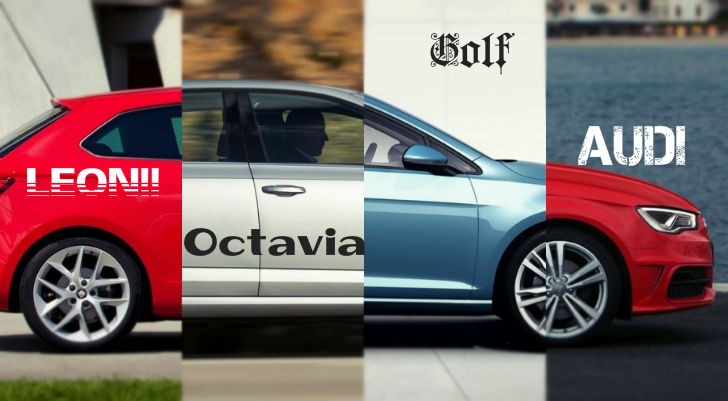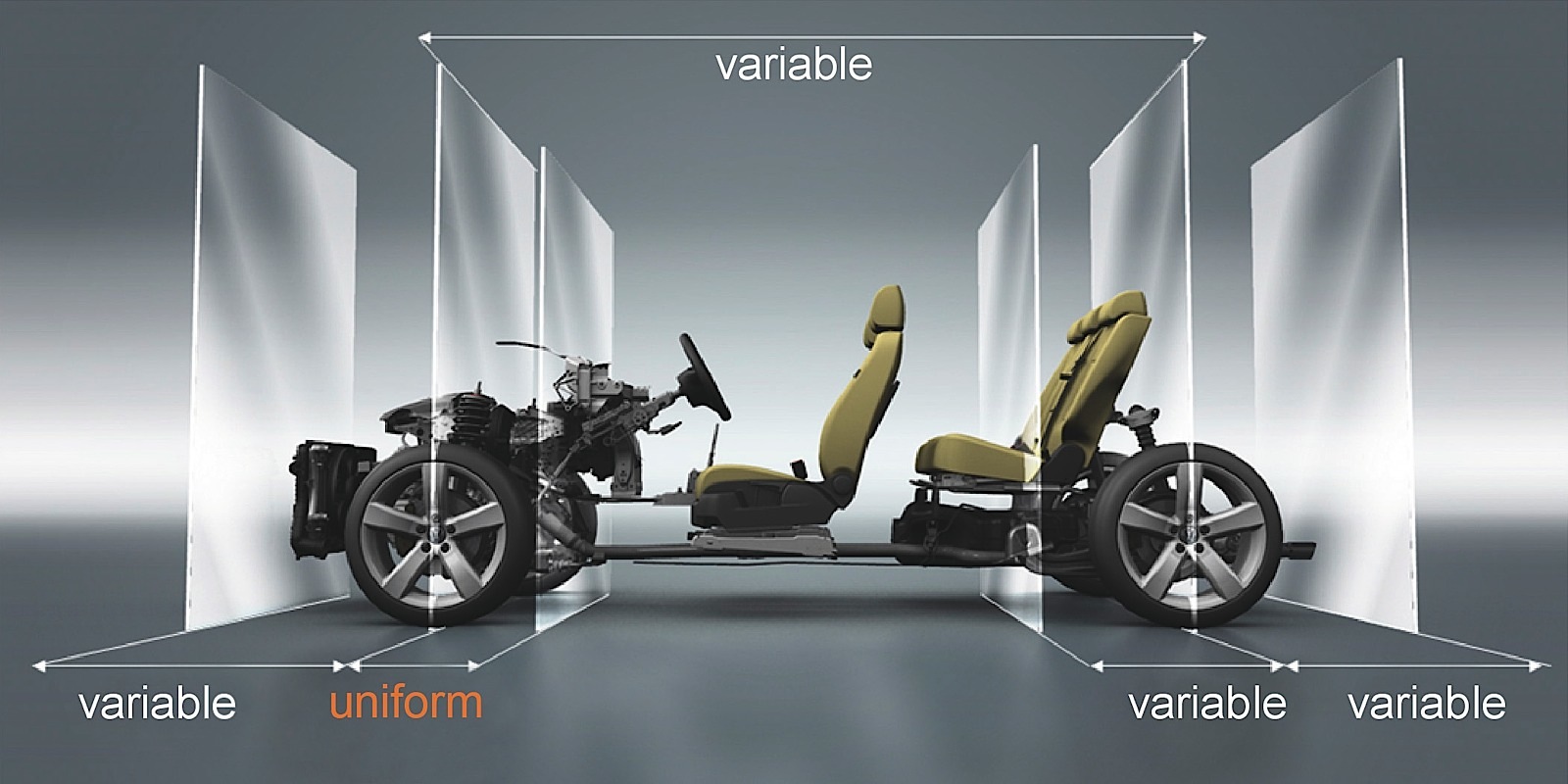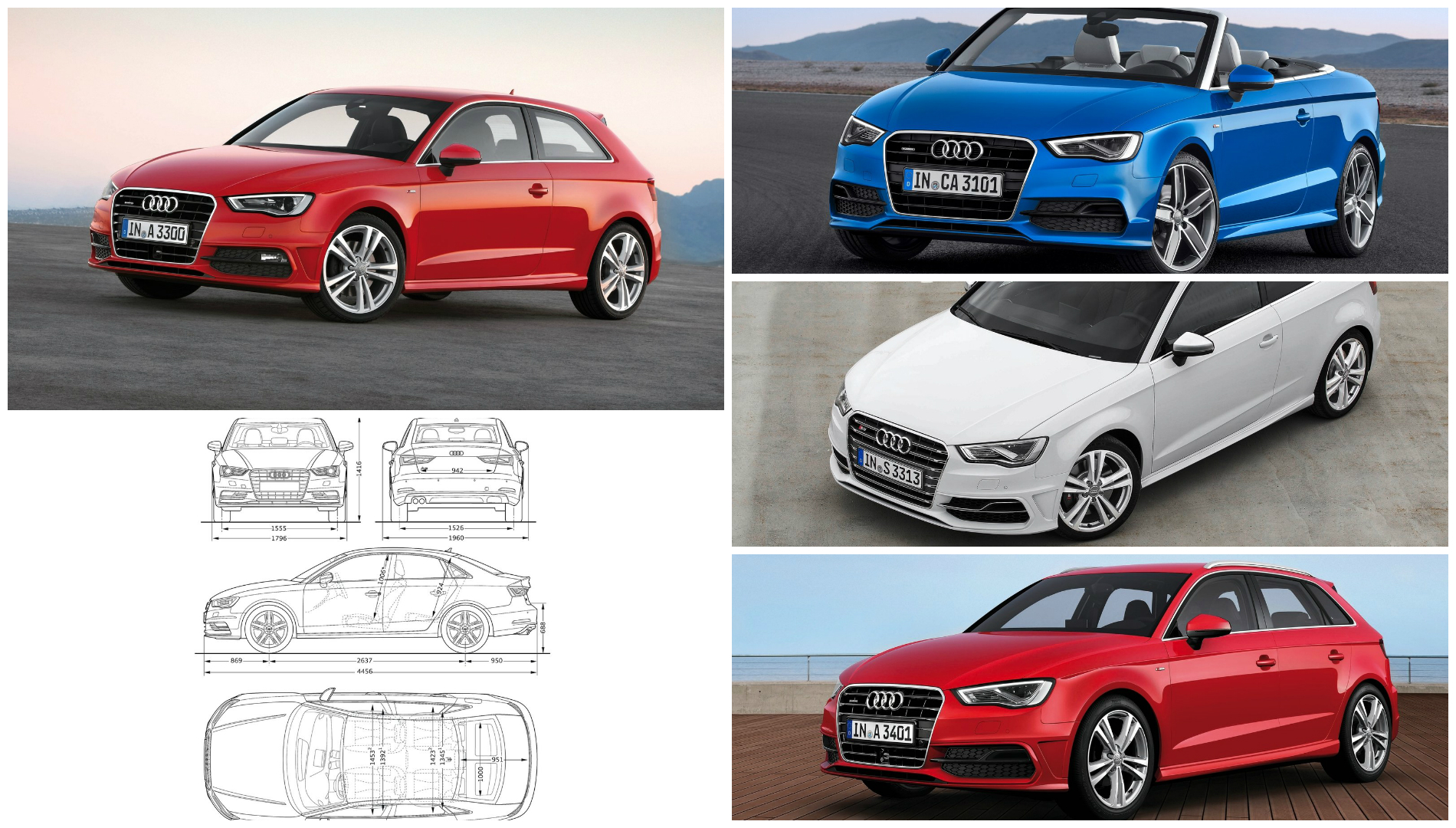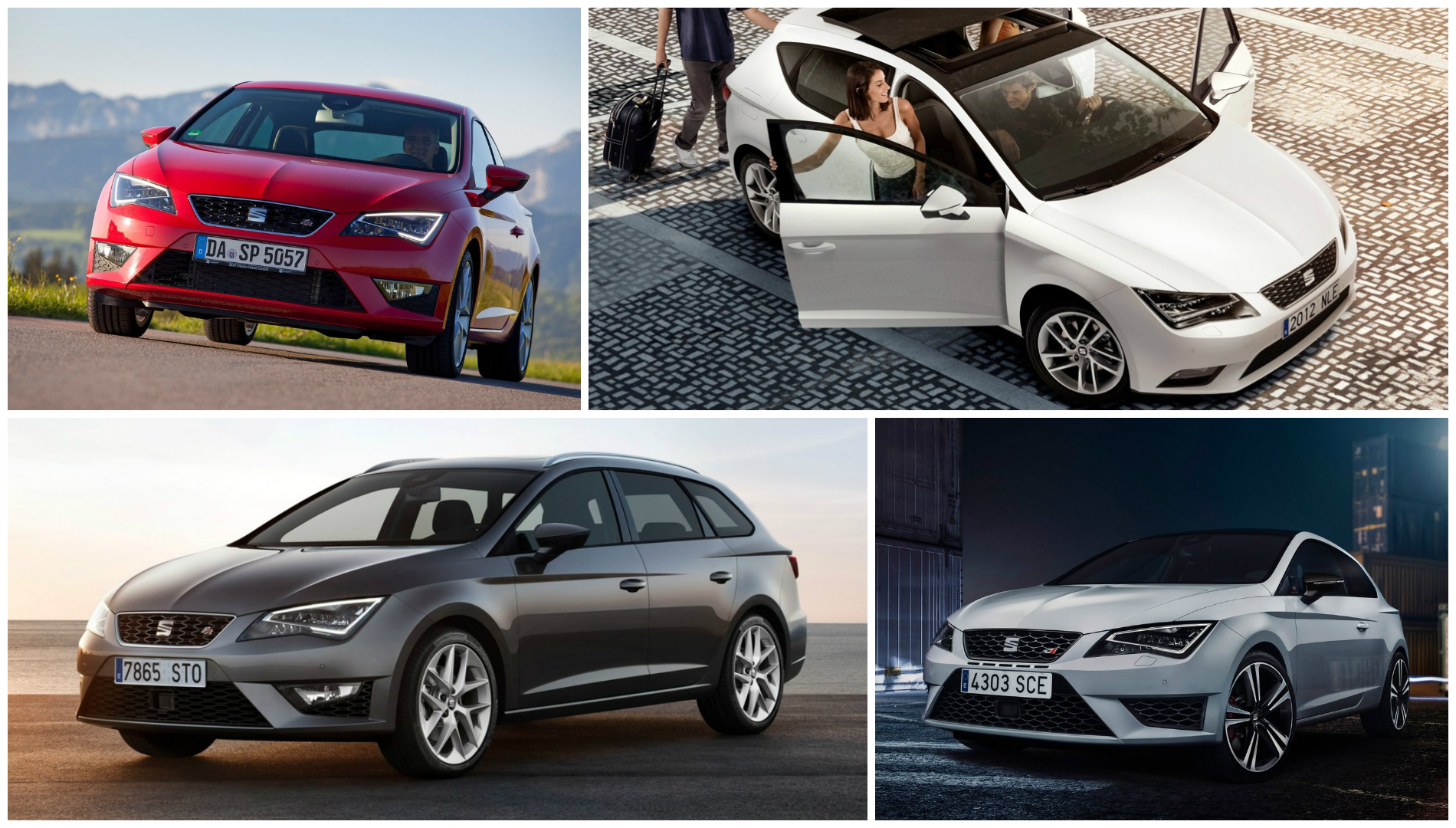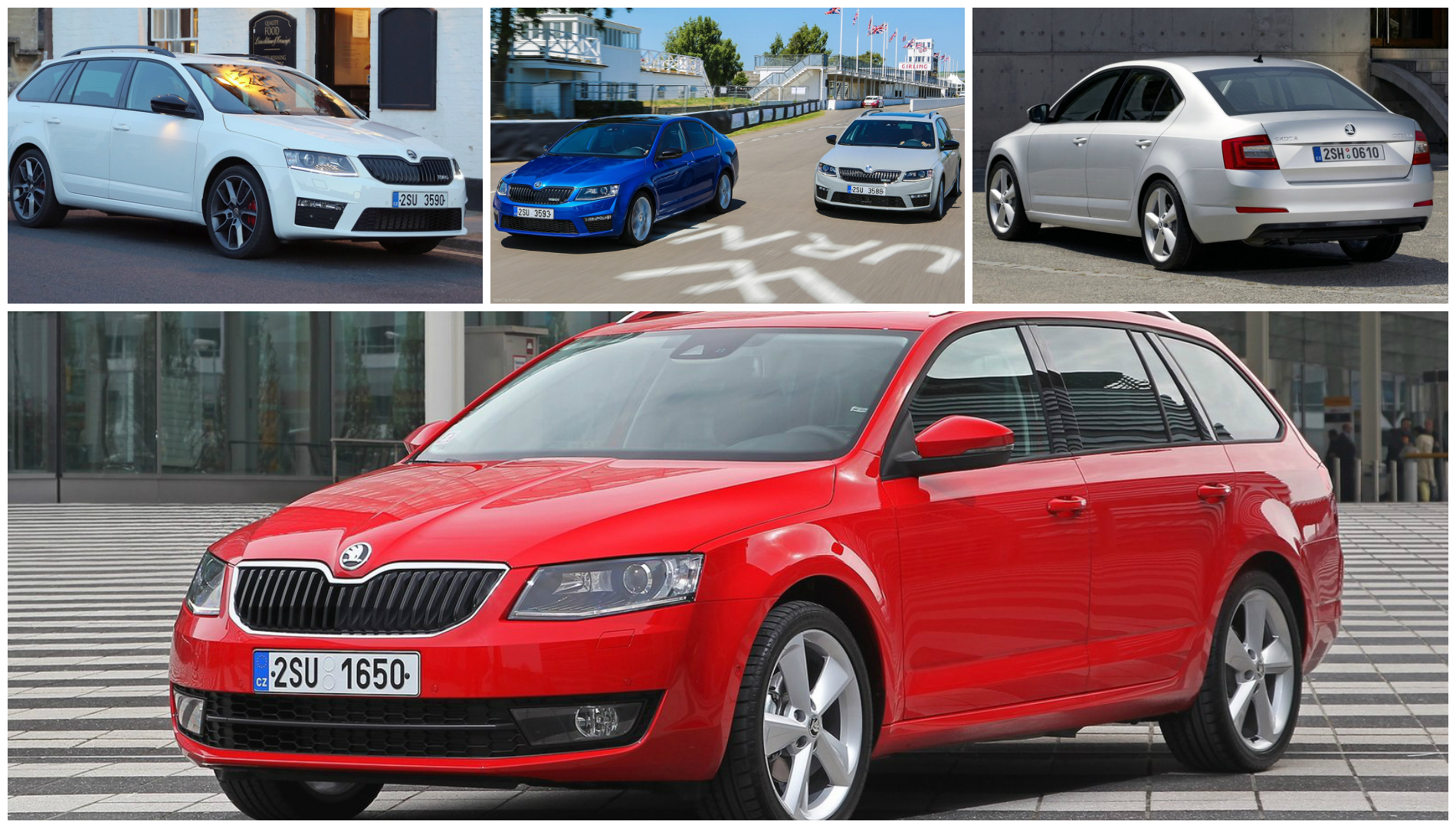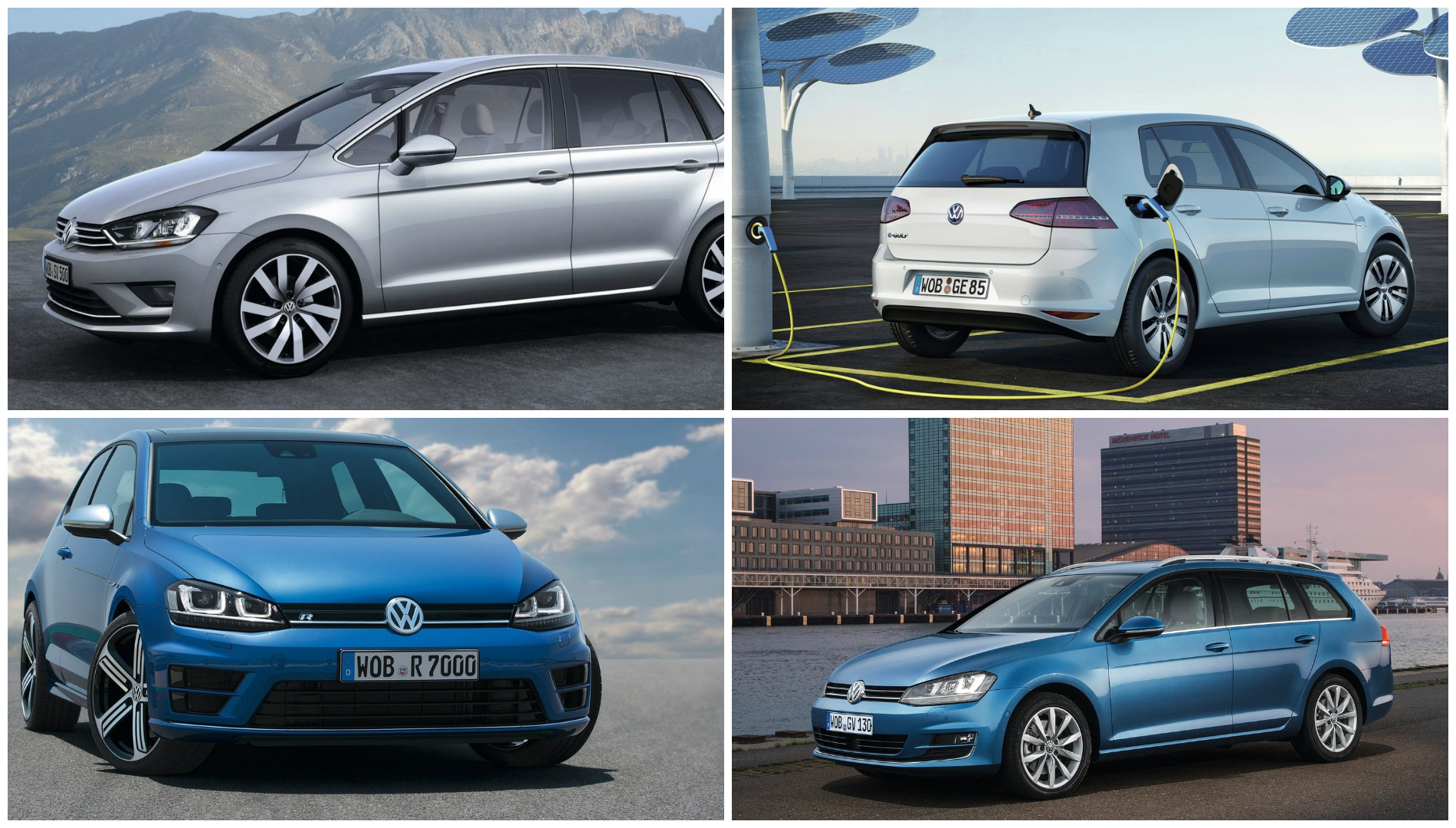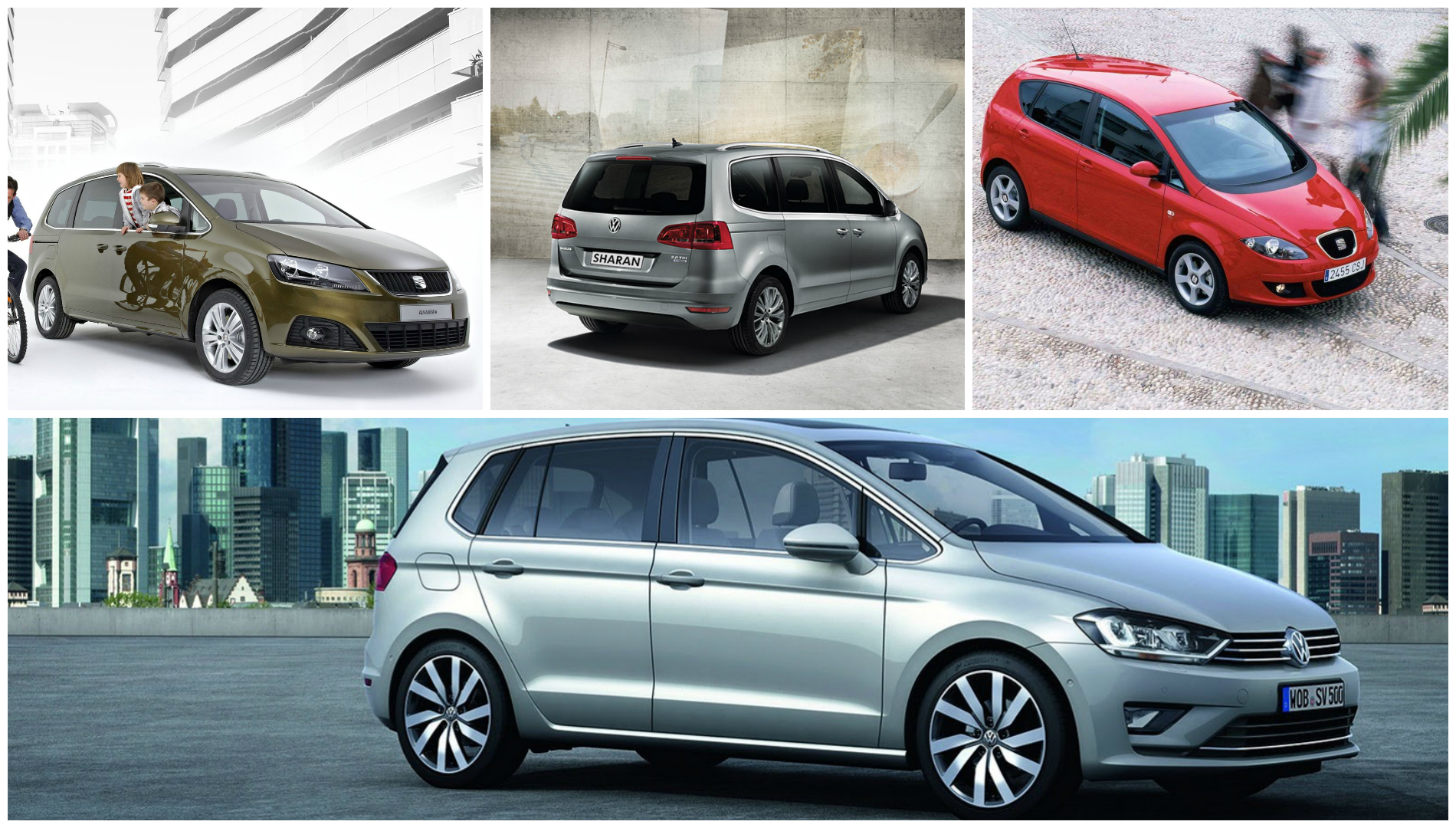Last year, Volkswagen Group sold close to 10 million vehicles, their most successful year ever. And yet according the officials, this is only the tip of what they can do, as platform modularity will drive sales and profits even higher under a plan which they believe will help secure the No.1 position in the industry. By 2018, the Germans say 5 million cars each year will be assembled, sold and delivered using just one platform, the MQB. Across four major car brands, basically everything from a supermini to a 5-meter crossover will be based on this thing. Power will come from petrol, diesel, natural gas, hybrid, plug-in hybrid and fully electric engines. It sounds terribly complicated. It sounds like something that desperately needs explaining!
MQB will replace a huge variety of other platforms, starting with what's left of the PQ35 cars and continuing with PQ25 and PQ46 based models. It's big secret is that it's not actually a simple platform, but many components developed by different companies to work with each other. Short for "Modularer Querbaukasten", it roughly translates as "Modular Transverse Toolkit", meaning it's not actually one floorpan you stick engines to, not in the sense we used to know. Theoretically, all models will, however, have the same front axle placement, pedal box and engine positioning, despite varying wheelbase, track and external dimensions.
The history of the MQB platform officially starts right before the formal unveiling of the new Golf 7, back in 2012 at the Geneva Motor Show. A few months before that we're told how several types of powertrains developed separately or in bundled families will be adapted to fit the same mounting points: TSI petrols from the EA211 family, TDI diesels from the EA288 family, e-Drive fully electric modules and plug-ins, plus alternative and renewable fuel types that include EcoFuel CNG, BiFuel LPG and FlexFuel ethanol. The suspension components don't actually have to be the same, but they have to match to certain load-bearing points developed into the MQB.
The only fixed point is the distance between the pedal box and the front-wheel centre line. To address this, the nose is lengthened to create the engine bay. Small car = small overhang, large car = large one.
If you'd like that as a metaphor, this is like calling up Gordon Ramsay and the other judges of MasterChef to cook a single dish. Volkswagen dreams up something big that will put the competition out of business, Audi says it can cook up the perfect 1.8 TFSI turbo that goes with everything and Skoda says it will built the little engines and maybe throw in an old-fashioned handbrake to provide a sturdy taste.
There are four major protagonists to our story, the Audi A3, SEAT Leon, Skoda Octavia and Volkswagen Golf. So what makes each one of these special?
Let's start by looking at the Audi. While all animals are created equal, the A3 is more expensive and thus more equal. It has the widest selection of chassis and nameplates so far. Starting with a 3-door, they soon launched the 5-door Sportback, a great sedan model, a convertible, S3 versions of all these and every type of powertrain imaginable, including the e-tron plug-in hybrid with over 200 hp. And that's only the beginning.
What's special about the Audi is that unlike its sister models, all versions come with independent suspension. What's more, some of the front bits are made from aluminum, including the suspension and some of the bodywork. Everything's an option with this car, and it tends to get expensive. Navigation is more than twice as expensive as on the Skoda and comes in a pop-up screen. The A3 is crucial for the US market and China, but even based on European availability sales of the A3 jumped 43% in 2013.
The SEAT Leon was definitely the underdog of the group and it very much feels it. Of the quartet, it was the only one that was doing badly. Switching to MQB, the Leon took every major risk and cut a number of corners. Its formula is all about offering the most bang for the buck.Just to give you an example, in Britain LED headlights are offered for free as a buyer incentive and in the other markets they are cheaper than on a Golf or Audi. Any model with 122 hp (basically starting with the 1.4 TSI. This will switch to 125 hp soon) gets independent rear suspension. Golfs only get that from 150 hp upwards.
The cabin is not as well put together. We think part of the proble is the angularity, which makes the plastics look even cheaper. There are fewer soft-touch materials and fewer standard chrome trim pieces to go around. The upside is the cheapest of the bunch. The exterior is wonderful, thanks to design by a man who designs Lamborghinis for a living. What a beauty!
Turn the speakers on and the bass is strong. Wind the engine up and you notice it's less damped than the other models. You really get the sense then that this is the car for 25 to 30-something people who appreciate a bargain.
The Octavia was always a car that got great word of mouth reviews, but it used to be that Skoda had to take the platform made for the Golf and change it with cheaper suspension bits and a longer wheelbase. The Octavia thus earned the nickname "poor man's Golf". Not any more!
From de start, the MQB was developed to fit the Octavia's needs, which mostly center around 1.2 TSI and 1.6 TDI engines, simple suspension and the longest wheelbase so far developed on the platform. OK, so the materials aren't really top-notch but the cheaply upholstered cargo hold is huge at 590 liters for the sedan model. Fold the seats flat and it's like looking at the bed. The Octavia is designed to do the job of a Ford Mondeo, which technically is in a class above, more cheaply. It's not just the hold itself, but also the opening, far larger than on the sexy SEAT.
There's no design made for the sake of design with the Octavia III. The only thing you can get excited about is a larger set of wheels and some metallic paint. For the Skoda buyer, size matters much more than handling, so of all the models we mentioned this is the least sporty. Don't go buying a vRS thinking it's going to be as good as the Golf GTI or you'll be disappointed.
While they are simple, the buttons for the air-con or the door handles are practical and feel like they can be operated with gloves on. Skoda even throws in an ice scraper conveniently mounted inside the gas cap cover.
The MQB platform is pretty much synonymies with the Golf and you get the feeling Volkswagen let its car have the lion's share of the good equipment. The perceived quality level has jumped to the point where and we think a well-specced Golf 7 is better inside than a 2011 Audi A3.
Being the third most successful car ever made, the Golf had the most to lose out of the quartet and driving it you get the feeing that every component has been engineered with no risk involved. The wiper stalks are creamy-soft to use and the automatic headlight switch makes the perfect reassuring click. To give you a good example of the attention to detail, the seats are so good they won an award from AGR for their back support.
The chassis diversity is not as wide as the Audi A3, but there an equal amount of expensive and well built options. The variety of engine choices is huge, from the most basic 86 hp 1.2-liter TSI to a 300 hp 2.0-liter TSI fitted to the hardcore Golf R. The Golf is also the first car in the world to be made available with three regular hot hatch versions, the GTI and GTD being joined by the GTE plug-in hybrid.
Skoda has officially announced hat a new Fabia will be launched in Autumn 2014. However, reports have indicated this will continue to be based on the old PQ25 architecture that also underpinned the Rapid range of compacts. We believe MQB will thus only start being used for superminis towards the beginning of 2017. Volkswagen has ruled out a Polo-sized SUV, which means the other brands are unlikely to have one either.
Sportscars: the new TT and...
Crisp and sharp, an evolution of its two predecessors, the Audi TT Mk3 was revealed weeks ago at the Geneva Motor Show, offering up to 310 horsepower. Just like the previous generation, the platform is shared with the A3, so it's not surprising that 50 kilograms have been shaved compared to the Mk2.
At 4.18 meters, it's the most compact MQB car to date and its wheelbase is also the shortest. Most of the groundwork for its development had already been done on other projects, but the TT does carry a number of innovations, like an 2.0 TFSI engine that makes 310 hp, a new record for the Group, and two aluminum die-cast pieces that hold the cargo hatch and give strength to the roof.
This next video will explain the lightweight construction of the new TT:
MQB was developed by the whole group, but the TT raises a number of problems Audi had to solve on its own. An all-digital speedometer that also plays the role of a navigation system was developed by them specifically for this car. They're also now having to figure out how to fit a new 2.5-liter, five-cylinder TFSI engine into the TT-RS and a whole RS3 range, which might for the first time include a sedan.
A brand new Scirocco is expected to pick up the mantle in 2017. No official word on the exact details, but 4Motion all-wheel drive and a hardcore RS model are being rumored. Most importantly, it could have a conventional coupe design rather than the 3-door hatchback. The slope of the roof will be more pronounced.
At the moment, Skoda and SEAT are unlikely to develop their own coupes. But speaking of coupes, the current generation Beetle is of course also going to be based on the modular toolkit, probably in 2018. However, a hardcore Beetle R with 280 hp has been developed by Volkswagen and will debut within the corse of this year. It will have a limited slip differential and should take under well under 6 seconds to reach 100 km/h. 4Motion AWD is, however, unlikely to be offered.
Audi might be the first to build another MPV, badged as a new member of the A3 family. This would compete directly with the Mercedes B-Class, which is a resounding success for Mercedes, the best selling car in Germany for 2013. Its key attributes will be a taller roof and seating position, flexible seating and cubbies dotted around the cabin. SEAT should have its own MPV on the way. Everybody will of course remember the Altea and its derivatives, the Altea XL and Altea Freetrack. But there's also the bigger Alhambra, the second generation of which was launched in 2010. Both it and the Volkswagen Sharan are based on the PQ46, which we mentioned earlier is being succeeded by the MQB. Replacements should come after the Passat in 2015 or later.
The Tiguan II will be about the same size as the current model and could be available in three body styles by adding a coupe and an extended wheelbase model. This is of course the long-rumored production version of the Cross Coupe Concept which is rumored to be approximately 550mm (22 inches) longer than the standard Tiguan and will be built in the United States or the new factory in Mexico.
Skoda could also launch its own version, a flagship crossover with three rows of seats, likely to be produced at the Kvasiny factory int the Czech republic.
Besides the compacts which we centered our article on, these SUVs and crossovers will be the most important additions and will form a significant portion of the anticipated 5 million MQB-based sales group-wide.
The history of the MQB platform officially starts right before the formal unveiling of the new Golf 7, back in 2012 at the Geneva Motor Show. A few months before that we're told how several types of powertrains developed separately or in bundled families will be adapted to fit the same mounting points: TSI petrols from the EA211 family, TDI diesels from the EA288 family, e-Drive fully electric modules and plug-ins, plus alternative and renewable fuel types that include EcoFuel CNG, BiFuel LPG and FlexFuel ethanol. The suspension components don't actually have to be the same, but they have to match to certain load-bearing points developed into the MQB.
The only fixed point is the distance between the pedal box and the front-wheel centre line. To address this, the nose is lengthened to create the engine bay. Small car = small overhang, large car = large one.
If you'd like that as a metaphor, this is like calling up Gordon Ramsay and the other judges of MasterChef to cook a single dish. Volkswagen dreams up something big that will put the competition out of business, Audi says it can cook up the perfect 1.8 TFSI turbo that goes with everything and Skoda says it will built the little engines and maybe throw in an old-fashioned handbrake to provide a sturdy taste.
There are four major protagonists to our story, the Audi A3, SEAT Leon, Skoda Octavia and Volkswagen Golf. So what makes each one of these special?
Let's start by looking at the Audi. While all animals are created equal, the A3 is more expensive and thus more equal. It has the widest selection of chassis and nameplates so far. Starting with a 3-door, they soon launched the 5-door Sportback, a great sedan model, a convertible, S3 versions of all these and every type of powertrain imaginable, including the e-tron plug-in hybrid with over 200 hp. And that's only the beginning.
What's special about the Audi is that unlike its sister models, all versions come with independent suspension. What's more, some of the front bits are made from aluminum, including the suspension and some of the bodywork. Everything's an option with this car, and it tends to get expensive. Navigation is more than twice as expensive as on the Skoda and comes in a pop-up screen. The A3 is crucial for the US market and China, but even based on European availability sales of the A3 jumped 43% in 2013.
The SEAT Leon was definitely the underdog of the group and it very much feels it. Of the quartet, it was the only one that was doing badly. Switching to MQB, the Leon took every major risk and cut a number of corners. Its formula is all about offering the most bang for the buck.Just to give you an example, in Britain LED headlights are offered for free as a buyer incentive and in the other markets they are cheaper than on a Golf or Audi. Any model with 122 hp (basically starting with the 1.4 TSI. This will switch to 125 hp soon) gets independent rear suspension. Golfs only get that from 150 hp upwards.
The cabin is not as well put together. We think part of the proble is the angularity, which makes the plastics look even cheaper. There are fewer soft-touch materials and fewer standard chrome trim pieces to go around. The upside is the cheapest of the bunch. The exterior is wonderful, thanks to design by a man who designs Lamborghinis for a living. What a beauty!
Turn the speakers on and the bass is strong. Wind the engine up and you notice it's less damped than the other models. You really get the sense then that this is the car for 25 to 30-something people who appreciate a bargain.
The Octavia was always a car that got great word of mouth reviews, but it used to be that Skoda had to take the platform made for the Golf and change it with cheaper suspension bits and a longer wheelbase. The Octavia thus earned the nickname "poor man's Golf". Not any more!
From de start, the MQB was developed to fit the Octavia's needs, which mostly center around 1.2 TSI and 1.6 TDI engines, simple suspension and the longest wheelbase so far developed on the platform. OK, so the materials aren't really top-notch but the cheaply upholstered cargo hold is huge at 590 liters for the sedan model. Fold the seats flat and it's like looking at the bed. The Octavia is designed to do the job of a Ford Mondeo, which technically is in a class above, more cheaply. It's not just the hold itself, but also the opening, far larger than on the sexy SEAT.
There's no design made for the sake of design with the Octavia III. The only thing you can get excited about is a larger set of wheels and some metallic paint. For the Skoda buyer, size matters much more than handling, so of all the models we mentioned this is the least sporty. Don't go buying a vRS thinking it's going to be as good as the Golf GTI or you'll be disappointed.
While they are simple, the buttons for the air-con or the door handles are practical and feel like they can be operated with gloves on. Skoda even throws in an ice scraper conveniently mounted inside the gas cap cover.
The MQB platform is pretty much synonymies with the Golf and you get the feeling Volkswagen let its car have the lion's share of the good equipment. The perceived quality level has jumped to the point where and we think a well-specced Golf 7 is better inside than a 2011 Audi A3.
Being the third most successful car ever made, the Golf had the most to lose out of the quartet and driving it you get the feeing that every component has been engineered with no risk involved. The wiper stalks are creamy-soft to use and the automatic headlight switch makes the perfect reassuring click. To give you a good example of the attention to detail, the seats are so good they won an award from AGR for their back support.
The chassis diversity is not as wide as the Audi A3, but there an equal amount of expensive and well built options. The variety of engine choices is huge, from the most basic 86 hp 1.2-liter TSI to a 300 hp 2.0-liter TSI fitted to the hardcore Golf R. The Golf is also the first car in the world to be made available with three regular hot hatch versions, the GTI and GTD being joined by the GTE plug-in hybrid.
Future Plans in Detail: Vans, Crossovers, SUVs and Even Sportscars
The quartet of compacts is or rather was only the beginning for MQB. As the Group continued to invest in the expansion of its model range, other nameplates were also built using the toolkit.Superminis: It Could Be a While
It was originally expected that new Fabia, Polo and Ibiza models would come out immediately after the compacts. However, that did not happen as weakness in domestic European markets convinced decision-makers to prioritize investment in technology. Facelifts were instead offered: Ibiza in 2013, Polo at the beginning of this year and the Audi A1 probably in a few months' time.Skoda has officially announced hat a new Fabia will be launched in Autumn 2014. However, reports have indicated this will continue to be based on the old PQ25 architecture that also underpinned the Rapid range of compacts. We believe MQB will thus only start being used for superminis towards the beginning of 2017. Volkswagen has ruled out a Polo-sized SUV, which means the other brands are unlikely to have one either.
Sportscars: the new TT and...
Crisp and sharp, an evolution of its two predecessors, the Audi TT Mk3 was revealed weeks ago at the Geneva Motor Show, offering up to 310 horsepower. Just like the previous generation, the platform is shared with the A3, so it's not surprising that 50 kilograms have been shaved compared to the Mk2.
At 4.18 meters, it's the most compact MQB car to date and its wheelbase is also the shortest. Most of the groundwork for its development had already been done on other projects, but the TT does carry a number of innovations, like an 2.0 TFSI engine that makes 310 hp, a new record for the Group, and two aluminum die-cast pieces that hold the cargo hatch and give strength to the roof.
This next video will explain the lightweight construction of the new TT:
MQB was developed by the whole group, but the TT raises a number of problems Audi had to solve on its own. An all-digital speedometer that also plays the role of a navigation system was developed by them specifically for this car. They're also now having to figure out how to fit a new 2.5-liter, five-cylinder TFSI engine into the TT-RS and a whole RS3 range, which might for the first time include a sedan.
A brand new Scirocco is expected to pick up the mantle in 2017. No official word on the exact details, but 4Motion all-wheel drive and a hardcore RS model are being rumored. Most importantly, it could have a conventional coupe design rather than the 3-door hatchback. The slope of the roof will be more pronounced.
At the moment, Skoda and SEAT are unlikely to develop their own coupes. But speaking of coupes, the current generation Beetle is of course also going to be based on the modular toolkit, probably in 2018. However, a hardcore Beetle R with 280 hp has been developed by Volkswagen and will debut within the corse of this year. It will have a limited slip differential and should take under well under 6 seconds to reach 100 km/h. 4Motion AWD is, however, unlikely to be offered.
MPVs: the New Sportsvan Could Become an Audi A3
There's no shortage of practical estate cars based on the MPV platform, but there's only one MPV model right now, and that's the new Golf Sporsvan. This is a brand new nameplate designed to replace the Golf Plus, which was not a success for the VW brand. We're unsure of what to expect from this one either, as it lacks the pizzas of the C4 Picasso, but we're pretty sure there will be more like it.Audi might be the first to build another MPV, badged as a new member of the A3 family. This would compete directly with the Mercedes B-Class, which is a resounding success for Mercedes, the best selling car in Germany for 2013. Its key attributes will be a taller roof and seating position, flexible seating and cubbies dotted around the cabin. SEAT should have its own MPV on the way. Everybody will of course remember the Altea and its derivatives, the Altea XL and Altea Freetrack. But there's also the bigger Alhambra, the second generation of which was launched in 2010. Both it and the Volkswagen Sharan are based on the PQ46, which we mentioned earlier is being succeeded by the MQB. Replacements should come after the Passat in 2015 or later.
New Volkswagen Tiguan to Debut in 2016
Production of the new Tiguan SUV has been officially confirmed for 2016. Little else is known about the car, but it will most likely be co-developed with replacements for the Audi Q3, Skoda Yeti and a yet-unnamed SEAT model still pending approval. All are going to sit in the compact SUV class, rivaling the Toyota RAV4 and Honda CR-V, while most are expected to feature plug-in hybrid drivetrains.The Tiguan II will be about the same size as the current model and could be available in three body styles by adding a coupe and an extended wheelbase model. This is of course the long-rumored production version of the Cross Coupe Concept which is rumored to be approximately 550mm (22 inches) longer than the standard Tiguan and will be built in the United States or the new factory in Mexico.
Skoda could also launch its own version, a flagship crossover with three rows of seats, likely to be produced at the Kvasiny factory int the Czech republic.
Besides the compacts which we centered our article on, these SUVs and crossovers will be the most important additions and will form a significant portion of the anticipated 5 million MQB-based sales group-wide.
